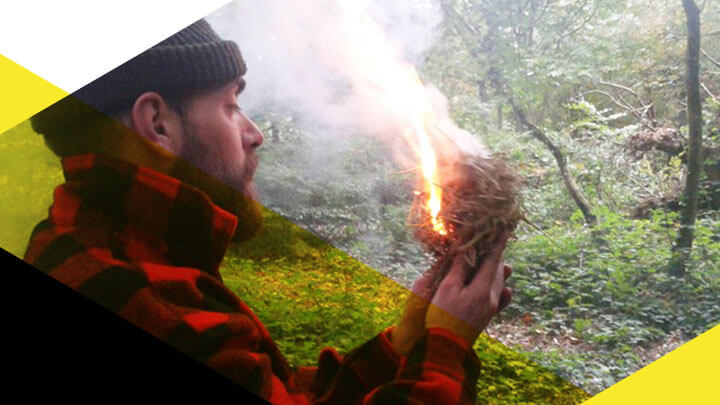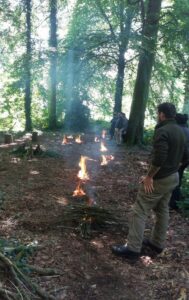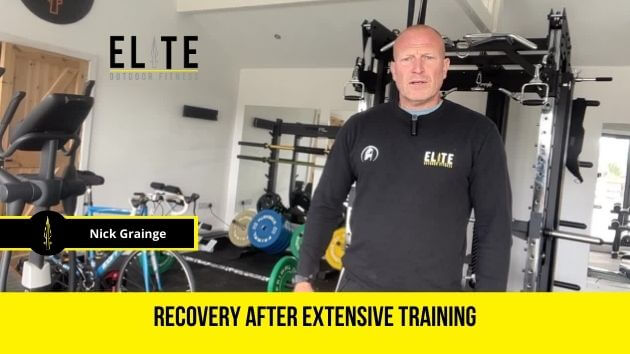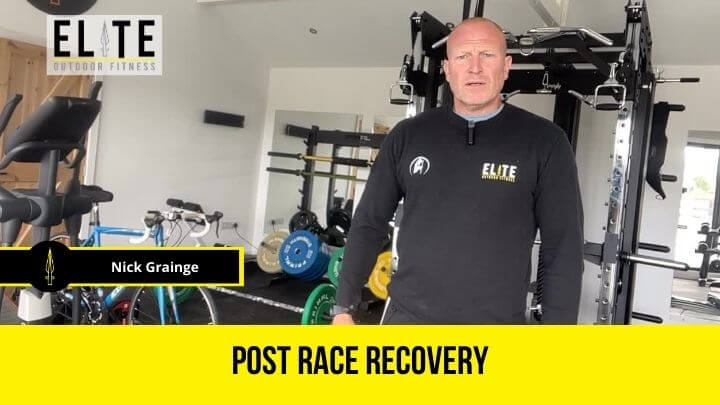The how-to guide of fire lighting
Fire lighting is an art when it’s for survival. Check out our guide, written by bushcraft expert, Andy Froy.

In every extreme wilderness survival situation being able to create and maintain a lifesaving fire is essential. The effort to create a fire is far outweighed by the many benefits it delivers.
Why you need a fire…
Fire will ensure you have:
Warmth…
- will help to keep your core body temp around 36.8°c to 37°c which is the optimum temperature that our body’s work the best at!
Psychological Reassurance
- A point to focus on! In my opinion, there is nothing better than sitting around a campfire after a hard day’s work! Also being able to get a fire started will be a massive morale booster in a Survival situation!
Light…
- in a SHTF situation, you will probably not have your head torch or the like. So, a fire will give you a better chance of seeing what’s going on around you at night.
Protection…
- from the extreme elements! Will help to combat the cold! Even in the desert, the nights can drop well below -4°c! It will help to keep predators and biting insects away.
Signalling…
- GTAS (Ground to Air Signal) for search and rescue. In the day, a large signal fire with lots of greenery over the top will give off plenty of thick white smoke that will punch through the thickest of tree canopies! At night, three signal fires in a triangle formation at a distance of 100ft apart from one another should also do the trick!!
Cooking…
- will make any food that you have acquired more palatable. If you are lucky enough to find, catch and kill a wild animal, then you will need to cook it to make it safe to eat (unless you’re Bear Grylls)
Preserve food…
- by smoking! A whole other article… Slice up any leftover meat as thin as possible and hang over your fire. You don’t want to cook it but basically dry it with the smoke! Leave to smoke for 12- to 24-hours, and there you have it, homemade biltong!!
Sterilising water
- There any many different ways to make suspicious water safe to drink: chemicals, filters, etc. But the failsafe method is to boil any suspect water on a 4-minute rolling boil. At sea level, the boiling point of water is 100°c this will make water safe to drink up to an altitude of 2000 meters! Any higher just boil for a little longer; as the air pressure changes so too does the boiling point of water!
Dry wet clothes…
- from the rain, perspiration or immersion. You will lose body heat 25 times faster in cold water than in the open air! So, if you do end up in the water, it is imperative that you dry your wet clothes ASAP!!
Harden wood…
- for tools and weapons. By placing a pointed stick (spear) under the embers of a fire, where there is no oxygen, you will be able to draw the moisture out of the wood and creating a super hard tip!
Fire starting materials
To make a successful fire you need three elements: heat, oxygen and fuel. If any one of these elements is missing, your fire will not burn.

Building a fire calls for an understanding of the dynamics involved. When fuel is burned, part of the heat from that combustion will go on to ignite the next piece of fuel. The hotter the fire, the better it will burn!
T-K-Max – is what I like to use when teaching! That is tinder, kindling and then maximum fuel.
Tinder
Whatever you use, natural or manmade tinder it MUST be something that is bone dry, fibrous and that can be lit by a small matchstick flame or sparks!
Manmade Tinders:
- Cotton wool – from tampons, field dressing.
- Rubber inner tubing – my kids hate me, their wheels keep going missing!
- Charcloth – place something 100% cotton eg: old pair of Jeans, old kitchen cloth etc into an old biscuit tin. Place a hole in the lid and stick it onto the fire. Smoke will bellow out of the hole! When the smoke stops take the tin out of the fire. When the tin is cold to the touch, open up and there you have it 100% Charcloth!!!
- Feather sticks – a great one for your knife skills! Batton into the centre of a 12-inch long round of dead dry wood and then make fine feathers/curls of wood that are small enough to be lit with a spark!! Check out my feather stick video on my YouTube channel for a more in-depth look.
- Lint – the little bits of fluff that you find at the bottom of your pockets or in between your toes from your socks!
Natural Tinder:
- Plant down’s (seed heads) – any dry, fluffy seed will take a spark. Most don’t last for too long though!
- Birch bark – all of the birches have a flammable paper-like bark that will light very easily with a spark and burn hot and long!
- Fungi (Amadu, Cramp balls) – cramp balls are a small dark brown to black balls that grow on dead or dying Ash trees. When dry, break open and hit the inside with a shower of sparks!
- Maya wood (fatwood) – small splinters of a very high resinous wood, cut from pine tree stumps then shaved and hit with a shower of sparks will burn long and strong!
- Dry leaves – dry holly leaves work well, scrunch up in your hands and hit with sparks!
- Dead dry grass – very dry dead grass works really well as a tinder! Fluff up, add some dry seed heads hit with sparks, and watch it burn!!
Kindling
Dry, dead, standing wood that snaps cleanly like the sound of a crackling fire. Start with matchstick-size, around a foot in length, elevating in sizes up to pencil-thick size, then little finger size.
Maximum fuel
Again, you will want to elevate up through different sizes gradually placing larger fuel onto your fire.
Setting your fire/fire lay
 Before we start we must clear the ground down to bare earth if possible. We don’t want to set fire to anything else in the area! Then we need to lay a small stick raft down of dead wood around finger thickness! This is what we are going to light our fire on. This will keep your tinder off the damp, cold ground, let it breathe and give your fire a great heart of embers as it grows!
Before we start we must clear the ground down to bare earth if possible. We don’t want to set fire to anything else in the area! Then we need to lay a small stick raft down of dead wood around finger thickness! This is what we are going to light our fire on. This will keep your tinder off the damp, cold ground, let it breathe and give your fire a great heart of embers as it grows!
Lighting your fire
This can be done in a great number of ways:
- Lighters – make it a clear plastic one so you can see how much fluid you have left!
- Matches – wind and waterproof ones work best!
- Ferrocerium rod – Ferro rod, spark stick, flint and steel, fire steel: produces sparks at a temp of around 3000°c (my go-to fire lighter)
- Batteries – car, phone, torch, 9v. Touch onto a strand of wire; it shorts out the battery but you’ve got a fire!
- Sun – magnifying glass, glass bottle, glasses, condom (filled with water), ice
- Chemicals – magnesium block, potassium permanganate (PP) and sugar, (PP) and antifreeze (little bit of Harry Potter magic)
- Flint and steel – very primitive method of creating sparks by friction
- Fire by friction – fire bow, hand drill, fire plough. These fire lighting methods have been around since Palaeolithic man roamed the earth!
As you can see, there is quite a lot that goes into successful fire lighting!
So, as I tell my students “practice makes permanent”. Get OCD with fire lighting. Practice in all weather conditions with all different materials and tools!
Andy
Related Articles
If you've enjoyed this post why not try these related articles…



